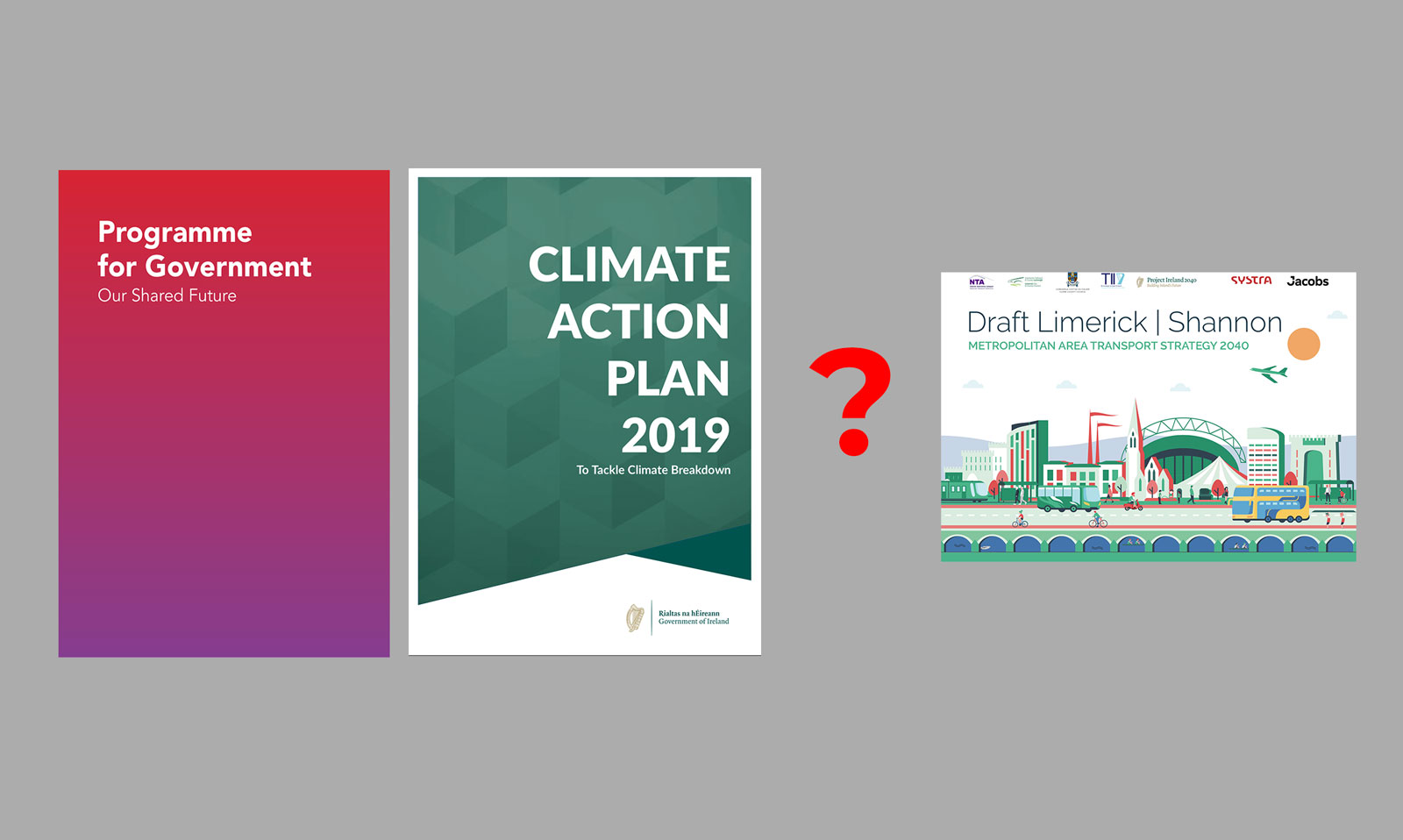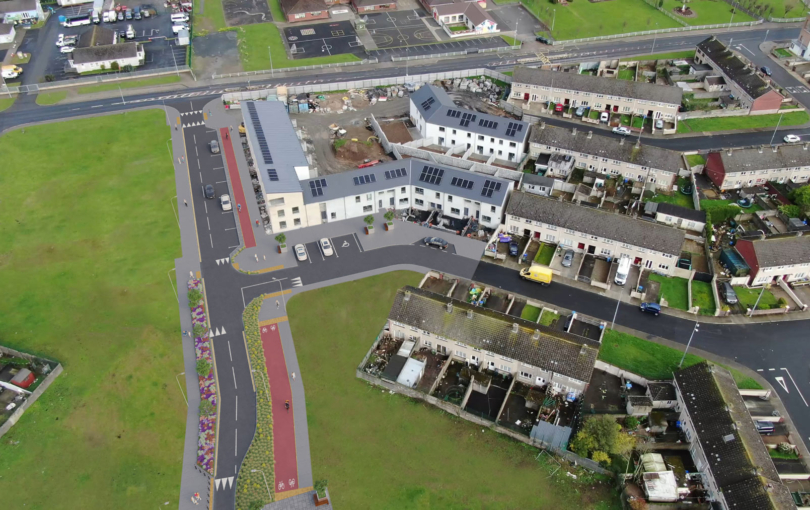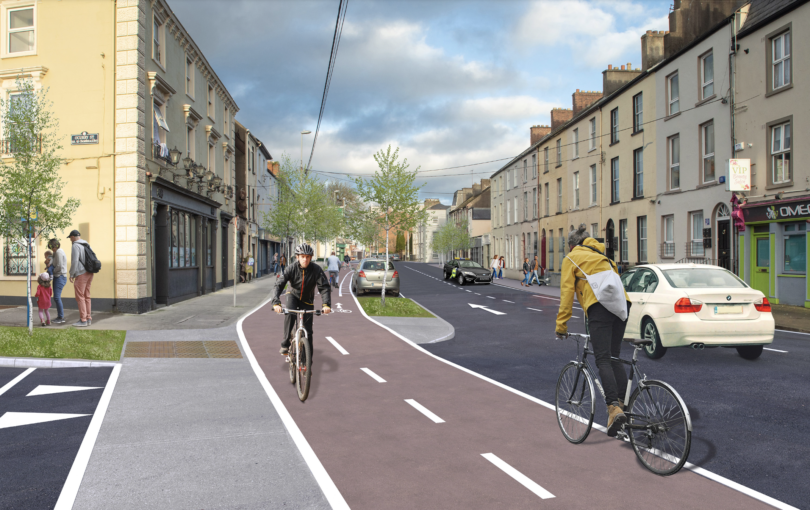In this article we analyse the Limerick Shannon Metropolitan Area Transport Strategy LSMATS from the perspective of alignment with the national climate action plan and the programme for government.
We have concluded that LSMATS is not aligned with the climate action or the programme for government as it does not sufficiently target modal shift toward non-carbon-based transport solutions for shorter journeys in the short or medium-term of the strategy.

We provide a table of suggested actions that if incorporated would bring LSMATS in line with climate action plan local authority legal commitments.
National Climate Action Plan – Requirements from the Transport Sector and Local Authorities
Ireland’s National Climate Action Plan 2019 outlines the growing challenge of climate breakdown that is facing both Ireland and all countries. In recognition of the dangerous impacts as a result of our changing climate, the Climate Plan sets out actions for all sectors of the economy to undertake in order to ensure that Ireland plays its part in addressing and preventing dangerous climate change.
The Climate Action Plan is a crucial policy as it helps Ireland to meet its requirements on climate action under EU and UN law, and it will be updated annually to make sure that Ireland continues to increase its efforts where possible. It focuses on the need to reduce greenhouse gas emissions from polluting sectors across the economy and on building resilience to climate impacts such as severe flooding and erosion of our coastlines.
One of the largest sources of greenhouse gas emissions in Ireland is the transport sector. In 2018 transport was the second largest contributor of greenhouse gas emissions in Ireland.
In order to address the negative impact of transport (emissions) on Ireland’s overall climate ambition, the Climate Action Plan established timebound actions for the transport sector, and for Local Authorities to help lead on those deliverables. The Plan identifies which Departments are expected to lead on cited actions and where Local Authorities have a role to play.
In doing so, the Climate Action Plan helps to set a blueprint for regional and local plans and strategies, ensuring that climate action and the goal to reduce greenhouse gas emissions is properly enshrined in such strategies. Local and regional authorities have an important role to play in delivering on the actions outlined. The Plan is also iteratively updated based on Ireland’s GHG emissions projections and the identification of further action needed.
As such, relevant plans and strategies such as the LSMATS should be drafted with a view to reviewing and revising up targets in order to align with the National Climate Action Plan.
LSMATS is not aligned with the Climate Action Plan
Transport is a significant contributor to Ireland’s carbon footprint coming in at a share of 12.2Mt (megatonnes) from our total emissions of 60.9Mt per annum.
The Climate Action Plan has committed to an additional 500,000 public transport and active travel journeys daily by 2035 as part of their suite of measures to reduce transport emissions by approximately half in the next decade. LSMATS contains no key performance indicators (KPI) or any acknowledgement of this goal within either it’s modeling or it’s outcomes.
The Climate Action Plan also requires that “policies need to be better aligned to achieve more ambitious targets for modal shift.” LSMATS only forecasts a modal shift from 2.1% to 4.2% for cycling in the time frame of 2020 to 2040. In no way could this be considered a significant or ambitious modal shift target.
Not only does this poor modal shift target conflict with the Climate Action Plan, it also contradicts Principle 3 of LSMATS itself which is it’s claim to “prioritise active and sustainable transport and reduce car dependency within the LSMA.”
The Climate Action Plan also calls to “expand sustainable-travel measures, including a comprehensive cycling and walking network for metropolitan areas of Ireland’s cities, with a particular emphasis on safety of cyclists.”
The associated Climate Action Charter for Local Authorities that Limerick Council has signed up to demands they “deliver a 50% improvement in energy efficiency by 2030” and to “ensure that policies and practices at local government level lead us towards low carbon pathways and put in place a process for carbon proofing major decisions, programmes and projects on a systematic basis, including investments in transport and energy infrastructure moving over time to a near zero carbon investment strategy.” It is clear that LSMATS does not provide any clear pathway to achieving the goals our local authority has pledged to uphold.
LSMATS is not aligned with the 2020 Programme for Government
The 2020 Programme for Government (PFG) calls for an average 7% per annum reduction in overall greenhouse gas emissions from 2021 to 2030 (a 51% reduction over the decade) and to achieving net zero emissions by 2050. There is no reference to this goal within LSMATS and as a result it is not aligned with the PFG.
As part of the budgetary process the Minister for Communications, Climate Action and Environment will propose a decarbonisation target range for each sector within the ceiling of the adopted carbon budgets, as well as an annual trajectory target range for each sector. The goal to be carbon neutral by 2050 is set in stone by the PFG. There is absolutely no acceptable excuse that this high level target has not been included in a transport plan due to run until 2040.
Modal shift towards active and sustainable transport is not accounted for in any reasonable fashion. KPIs for modal shift and emission reduction measures are completely lacking within LSMATS and so not allow for either any measurement or acknowledgement of the climate goals within the PFG. With the modelling showing that LSMATS is designed to increase car usage and ownership levels between now and 2040 it’s a strategy that by design will increase emissions, congestion and climate breakdown in complete opposition to both the Climate Action Plan and the Programme for Government.
Table of Actions for the Transport Sector
Below is a table of actions for which the Transport sector is tasked with undertaking. It should be noted that some of the actions outlined have either been undertaken or ongoing; a key area to highlight is how the LSMATS can deliver on relevant actions and how it can continue to improve and revise upwards any relevant targets, in line with national policy and commitments.
| Action | Key lead agency/actor | Supporting agency | Role for LSMATS | Timing |
| Every local authority to set forth a clear pathway and timetable for the installation of dedicated cycling infrastructure | DTTAS | Local/Regional Authorities | Include ambitious, realistic and timebound targets for cycling infrastructure in the Limerick-Shannon region. The targets may be both financial & related to #s of people cycling. Any such pathway should include a monitoring and accountability mechanism to ensure that those targets are met. | Q4 2020 |
| Increase funding in dedicated cycling infrastructure | DTTAS | Local/Regional Authorities | Outline timebound financial targets for dedicated cycling infrastructure. | Q4 2020 |
| Current transport infrastructure programmes to immediately be revised to achieve at least 10% expenditure on facilitating cycling | DTTAS | Local/Regional Authorities | As above | Q4 2020 |
| All cities with a population exceeding 75,000 to produce a sustainable transport plan by no later than June 2020 for review by the NTA and DTTAS
|
Local/Regional Authorities | DTTAS | If this has not already be done, the LSMATS should include a dedicated section on sustainable transport for Limerick city, further tasking the city council to detail clear actions for sustainable transport. | Q2 2020 |
| A climate Action Charter for each Local Authority through the use of a Ministerial policy | Local/Regional Authorities | If not already undertaken by the respective Local Authorities, the LSMATS should require Limerick & Shannon metropolitan areas to establish and adopt a Climate Action Charter, which includes the role of sustainable transport in achieving Ireland’s climate & energy targets. | Not identified | |
| Local Authorities to establish a baseline of current climate change activities and establish best practices | Local/Regional Authorities | The LSMATS should identify existing (baseline) efforts in the transport sector that contribute to climate action, helping to outline what, when and how to progress further action. | Not identified | |
| Publish public consultation on public/sustainable transport policy, including rural transport | NTA/DTTAS | The consultation is being reviewed – an updated mobility plan will be an important reference for informing on revisions of the LSMATS | Q3 2019 | |
| Work with DTTS and the NTA and other stakeholders to develop policy measures that integrate land use and transport planning in terms of the spatial pattern and urban form of development and transport/mobility, including the development of updated, place-related targets for sustainable mode share | A commitment/identification of measures in the LSMATS to integrate land use and transport planning in terms of the spatial pattern and urban form of development and transport/mobility | Not identified | ||
| Commission a Demand Management study to: – Consider key demand management drivers in an Irish context (e.g. congestion, air quality, climate considerations) – Review international best practices on measures such as congestion charges, LEZs, and parking policies – Recommend most appropriate responses for Dublin/Cork/ Galway/Limerick taking into account overall transport strategies in each case | DTTAS /NTA | Local/Regional
Authorities |
The LSMATS should apply on-going research and recommendations on related issues such as congestion, air quality and climate, with a view to integrating relevant recommendations that apply to the region and the strategy. | Q4 2019 |
| Based on the findings of study, develop proposals for setting an appropriate regulatory framework;
|
DTTAS /NTA | Local/Regional
Authorities |
As above | Q4 2020 |
| Establish a Park and Ride Development Office within NTA and develop a five-year strategy and implementation plan with specific timelines | DTTAS /NTA | Local/Regional
Authorities |
The LSMATS should establish a workplan for implementing Park & Ride in line with the NTA plans and the five-year strategy identified. | Q4 2019 |
| Establish a Cycling Project Office within NTA and develop a five-year strategy and implementation plan with specific timelines | DTTAS /NTA | Local/Regional
Authorities |
The LSMATS should establish a workplan for work with Cycle Project Officers, particularly for data collection, timelines and cyclist needs. | Q4 2019 |
Acronyms:
DTTAS: Department of Transport Tourism & Sport – transport now overseen by the Minister for Climate Action, Communications Networks and Transport
DHLG: Department of Housing & Local Government


